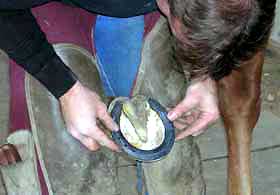|
 What
do Farriers do?
What
do Farriers do?
Bryan Quinsey, the Executive Director of the American Farrier's Association, argues that farriers do not only shoe horses, they provide foot and hoof care for nearly 7-million horses in the United States.
He
also asserts that "each
one of these horses is literally one hoof away from success
or failure, contentment or pain, life or death, and farriers
are positioned to determine the difference." (Bryan
Quinsey, AFA 34th Annual
Convention)
According to the American Farrier's Association, "Choosing
a farrier to provide hoof care for your
horse is one of the most important decisions you will
make for the well being of your horse. Improper
hoof care can lead to injury and/or lameness, and may
reduce your horse's ability to reach his full potential." (AFA, "Choosing
a Farrier")
***
The Evolution of Farriery
by Judith MulhollandDr. Judith Mulholland, an Australian veterinarian and farrier, traces the Evolution of Farriery. She demonstrates with excellent images and narration what good farrier practice is all about: "leaving the horse sounder than you found it."
She
explains why we shoe horses, elaborates on
trimming theories, concluding with "The golden rule
of veterinary medicine, farriery and trimming your own
horse's feet is “first do no harm”,
if your horse has bad feet, trim it “little and often”.
I am confident that poor hooves can be dramatically improved
by one years worth of good, regular farriery care; but,
if that good farriery stops the hooves will revert to what
ever problems they had previously if the hoof is predisposed
to it by poor limb and foot conformation or environmental
factors such as wet ground and poor diet. Naked and natural
work best when a hoof is normal conformation or is slightly
contracted. When a hoof is abnormal e.g., flat soled that
must be dealt with first. A horse limping around with thin,
prolapsed soles due to poor conformation, flat feet or
neglected chronic laminitis and sole pressure is miserable
and requires "professional" quality farriery to relieve
the discomfort. In the short term shoes e.g., glue-on,
nail-on, slip-on etc., or reconstruction techniques may
be essential to give that animal comfort. Providing non
painful answers to our farriery problems is our
obligation as horse-owners, farriers and veterinarians.
So the answer to this issue is yes, there is a lot of good
in the core of trimming theories and natural horse ideals.
But, beware of those who have got hold of some of the information
and some of the principles and then try to baffle you with “bull-dust” and
leave you with a horse that has been over-trimmed and is
foot sore. Farriery is all about leaving the horse sounder
than you found it."
(Judith Mulholland, http://www.farriervet.com/index.html)
>>>
Read the whole article and check out her
excellent website

